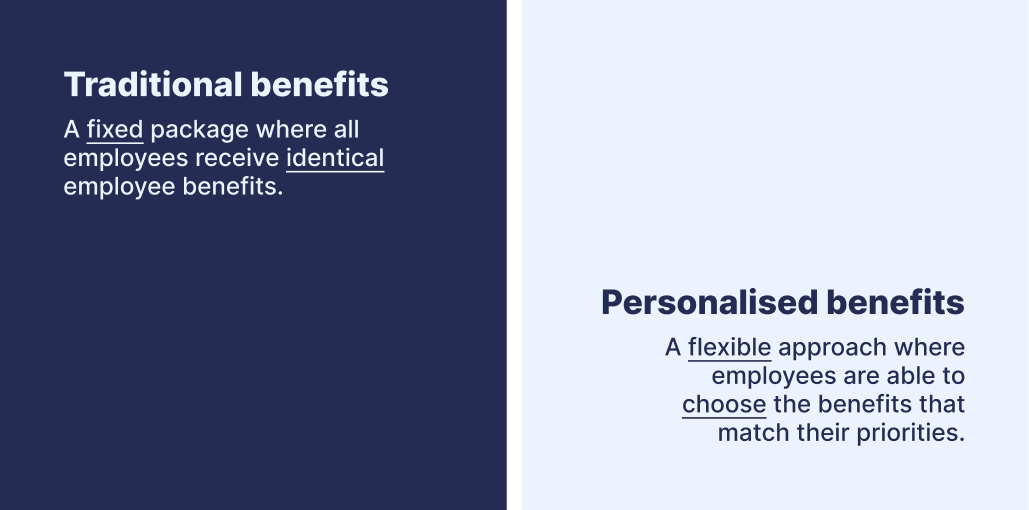Your sports-mad new hire is thrilled about the gym membership. But your working parents wish you'd swap it for childcare vouchers instead. And your expat cohort? They just want flexibility to work from anywhere for a few weeks to spend more time with family.
Standard benefits packages simply don't work anymore – not when your team spans multiple generations, life stages, and circumstances.
The solution seems obvious: personalise your benefits offering.
But too much choice can overwhelm employees and creates admin chaos. Too little, and you're back to one-size-fits-all.
We spoke to Sarah Jefferys, Chris Andrew, and Jenny Packer from Gallagher about how to strike the right balance. In this guide, we'll explore what personalised benefits actually mean, why they matter, and six expert considerations for getting them right.
What are personalised benefits?
Personalised benefits allow employees to select the employee benefits package that best suit their individual needs and circumstances, from a range of benefits choices available.
Unlike traditional one-size-fits-all benefits packages where every employee receives the same standard offering, personalised benefits recognise that your workforce has diverse needs. A working parent values childcare support differently to how a recent graduate values a commuting allowance.
At their core, personalised benefits give employees agency over their total compensation package. This might mean choosing between different benefit options, or accessing a flexible budget to spend on benefits that matter most to them.

Why are personalised benefits important?
Employee benefits are a critical component of your employee value proposition. They play a vital role in attracting talent in competitive markets and driving engagement and retention once employees join.
Get them wrong, and you risk losing people to competitors who better understand what motivates their team.
But not all employees value the same benefits.
"Ultimately we're dealing with human beings," explains Chris Andrew, Communication Consulting Lead at Gallagher. "Every single one of us is different and unique and we have our own unique needs."
This has always been true to an extent, but it's especially pronounced in today's diverse, global workforces, with companies now employing people across multiple generations, countries, life stages, and circumstances.
In fact, Gallagher's 2024 Workforce Trends Report found that 42.4% of organisations cite appealing to a diverse workforce with different preferences as their top Rewards challenge, and this has remained in the top three challenges for seven consecutive years.
Standard, one-size-fits-all employee benefits packages can't serve this diversity effectively (unless you have unlimited budget!) – which leaves organisations with benefits that simply aren’t fulfilling their purpose.
Subscribe to our newsletter for monthly insights from our compensation dataset and network of experts, to help you navigate a career in Rewards 📩
How to introduce personalised benefits effectively: 6 expert considerations
Getting personalised benefits right requires balancing flexibility with structure, understanding your workforce without making assumptions, and communicating effectively about what you offer. It's a complex challenge.
So, we asked the experts at Gallagher – Sarah Jefferys (Head of Reward Consulting), Chris Andrew (Communication Consulting Lead), and Jenny Packer (Senior Reward Consultant) – to share their key considerations for making personalised benefits work.

1. Understand your workforce before you design anything
The biggest mistake organisations make is assuming they know what their employees need.
"Conduct staff surveys or run focus groups," says Sarah. "These give organisations invaluable information on how people are feeling, where frustrations may lie."
But the key is asking the right questions.
Don't just ask employees whether they like specific benefits – that's too narrow. Instead, dig deeper into their values and priorities.
One Gallagher client took this approach by asking employees how they would want to spend additional disposable income if they had it available. Would they focus on financial wellbeing, like paying off more of their mortgage or increasing pension contributions? Or would they prioritise childcare support because they're currently missing out on income opportunities?
"Instead of asking high level questions, they really dove in a bit more to get under the skin of how the budget could be used to really support people in their particular life stage," explains Sarah.
If internal data isn't available, Chris suggests using national statistics as a starting point.
"Look at national levels of certain types – whether that's about neurodivergence or about working parents," he explains. "Then apply those geographical level statistics onto your organisation. We've probably got these people within our organisation, are we supporting them?"
This matters because not all needs are visible. While generational differences or gender are relatively obvious, you may not know who has an invisible disability they haven't disclosed, or who's managing dual caring responsibilities on top of work responsibilities.
"Creating an environment where people feel free to be able to let their employers know if they need help with a particular thing is crucial", says Sarah.
"Ultimately we're dealing with human beings. Every single one of us is different and unique and we have our own unique needs."

Communication Consulting Lead at Gallagher
2. Find the balance between core benefits for all, and the personalised benefits choices that align strategically
There will always be some core benefits that matter to everyone – above-mandatory pension contributions, health insurance, a healthy amount of annual leave. These should be standard for all employees because they address fundamental needs.
The key is getting the balance right.
"It's rare for employees to have completely free reign and for employers not to set some core benefits," notes Jenny. Most organisations maintain a strong core package for everyone, then layer flexible options on top.
And those flexible options should align with your company's goals and culture, not just be a random selection of perks. Netflix offers unlimited leave to foster empowerment and autonomy in their very high performance culture. eBay offers paid sabbaticals after a certain period of service, demonstrating their commitment to wellbeing whilst rewarding loyalty.
"The holistic lever is around mindset and culture,” explains Sarah, “The benefits that will drive the behaviours you're looking for to achieve your organisation's goals."

3. Choose your delivery model
Once you've decided which benefits should be core and which should be personalised, you need to determine how employees will actually access those choices.
The Gallagher team identified the most common models organisations use:
- Core plus choice menu: Maintain your standard core benefits for everyone, then offer employees a selection of additional benefits they can opt into.
- Flexible budget allocation: Give employees a set personalised benefits budget that they can allocate across different benefit choices each year.
- Salary sacrifice: Allow employees to exchange part of their pre-tax salary for certain additional benefits. This is a tax-efficient option for both employer and employee, commonly used for pensions, childcare vouchers, or cycle to work schemes. Where an annual bonus is paid, this can also be offered via salary sacrifice, adding value.
The model you choose will depend on your organisation size, administrative capacity, culture, and compensation philosophy.
4. Don't offer too much choice
This might seem counterintuitive, but one of the biggest pitfalls in personalised benefits is overwhelming employees with options.
"Choice can also be very overwhelming," warns Sarah. "So instead of extensive customisation, I’d recommend providing measured choices."
Employee personas can be useful here for guiding employees toward benefits most relevant to their circumstances, rather than presenting an overwhelming menu of every option.
"Personas can help you get started in determining the groups of employees you have," says Chris. "But be aware that there are so many nuances in everyone's lives. Use them as a starting point, not the whole answer."
The principle: offer genuine choice, but within a structured framework that makes decisions manageable rather than paralysing.
"Choice can also be very overwhelming. So instead of extensive customisation, I'd recommend providing measured choices."

Head of Reward Consulting at Gallagher
6. Use technology to manage the administrative burden
One of the biggest barriers to personalised benefits is administrative complexity – and this can prevent some teams from exploring the opportunity.
"As organisations grow, they may need tech solutions," says Jenny. "Small startups can be very creative and 'free' in their approach – but can you keep that offering going as you grow?"
Benefits management platforms help employees find the offering that suits them, and help you to track usage and understand what's actually valuable to employees.
But Jenny is clear that compensation technology is an enabler, not a starting point.
Get the strategy right first – understand your workforce, design the right balance of core and flexible benefits, plan your communication. Then bring in technology to make it operationally feasible as you scale.
In summary: Personalised benefits require strategy, not just choice
Personalised benefits become a genuine differentiator in attracting and retaining diverse talent when you understand your workforce, balance core and flexible options strategically, communicate effectively, and limit the administrative burden.
Start by listening to your employees. Then design an approach to personalised benefits that aligns with your company culture, goals, and team needs.
And remember: having benefits policies isn't enough. Make them visible, get leaders modelling their use, and track what's actually valuable to your team.
If you’d be interested in trying our personalised benefits for your organisation, or you have a question about any of the advice in this article, get in touch with the Gallagher team.



